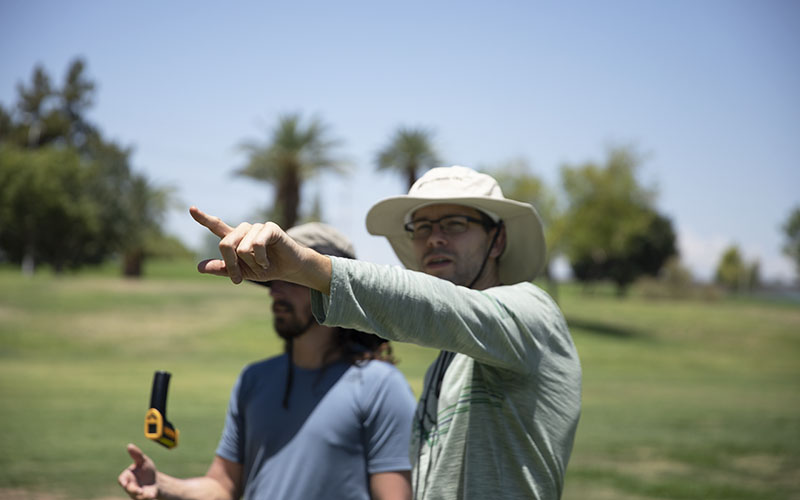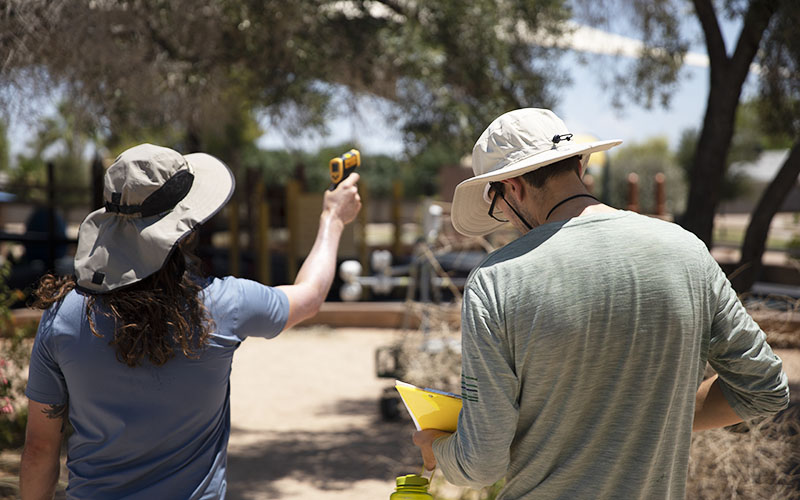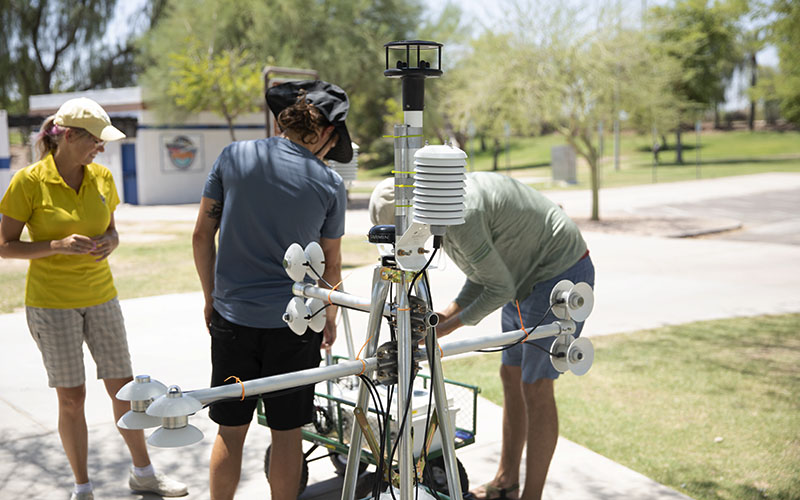Arizona in Focus is a podcast from Cronkite News, the news division of Arizona PBS. Each season we dive deep into a particular topic or story to bring you stories you haven’t heard elsewhere. Check out the rest of our episodes here, and subscribe on Apple Podcasts, Google Podcasts, or Spotify.
TEMPE – A cart clattered down one of the many concrete walkways in Kiwanis Park in early July, laden with scientific equipment. Its name is MaRTy, and the information it gathers has the potential to change the way policymakers think about, understand and plan for extreme heat.
If you ask Ariane Middel, assistant professor with Arizona State University’s School of Arts, Media and Engineering, she’ll tell you MaRTy is “a biometeorological mobile instrument platform.” It’s really a hand cart with thousands of dollars in scientific equipment used to measure and record different aspects of temperature. The instruments are mounted on a cross-shaped structure, and the whole rolling assembly stands about 4 feet tall.
There are two of these robotic units, which measure the mean radiant temperature, which is how people feel heat in different conditions, such as in shade, next to trees or bodies of water, and near different materials, including metal and concrete.
“It’s the temperature as you would experience it outside when you’re standing in the sun,” Middel said.
She and her team are gathering data on shade provided by different tree species, as well as by solid structures, such as buildings and awnings.
Her team in July went to Kiwanis Park, where they sampled about 30 types of shade.
“Throughout the day, we went out at midday or at noon, when the sun is at its highest point,” Middel said. They were back out in the afternoon when temperatures are at their hottest and then again after sunset “to look at the heat retention that happens under those shade structures and trees.”
Florian Schneider is a Ph.D. student in the Julie Anne Wrigley Global Institute of Sustainability at ASU who works on the MaRTy project. He said the information that’s gathered will help Tempe, Phoenix and other cities better plan where shade should be.
“(Tempe) wants to know what kind of shade is performing better or equally good, so that they can use artificial shade engineering on locations where natural shade cannot be positioned,” Schneider said.
This analysis in Tempe matters. A scientific study that came out this year shows Phoenix in 30 years will have a climate similar to Baghdad. And that concerns people like R.J. Price, the chief marketing officer for Downtown Phoenix Inc., a community development group that promotes the ongoing revitalization of the city’s center. He remembers a time not long ago when the lack of shade kept summer events from occurring in Phoenix because it simply was too hot to walk around.
“There were no summer convention programs because it was just simply too hot,” Price said. “I think as we’ve added more shade, people have seen that actually, we can have an event downtown in the summertime real well.”
Video by Amanda Slee/Cronkite News
Shade dictates the presence and flow of summertime foot traffic in Phoenix. Stores see increased sales when there’s better shading out front. People are willing to park farther from their destinations if they can shade their cars.
Schneider said one part of the shade project is to create a map to help cities better understand heat and shade.
“We can actually create a map for ASU to say, ‘Hey, these are hot spots. You have to do something here, ASU,’ or promote certain pathways for the students to walk or also nonstudents to create better walkability, like more protection from high temperatures or heat in general.”
Schneider said it’ll be at least a year to collect enough data to create hot-spot maps.
Middel said there are early indications that not all shade is created equal – solid shade, such as awnings, buildings and trees with dense canopies are the best at keeping the sun off your back.
This story is part of Elemental: Covering Sustainability, a new multimedia collaboration between Cronkite News, Arizona PBS, KJZZ, KPCC, Rocky Mountain PBS and PBS SoCal.
Listen to Arizona in Focus on our episodes here, and subscribe on Apple Podcasts, Google Podcasts or Spotify.
AlertMe



